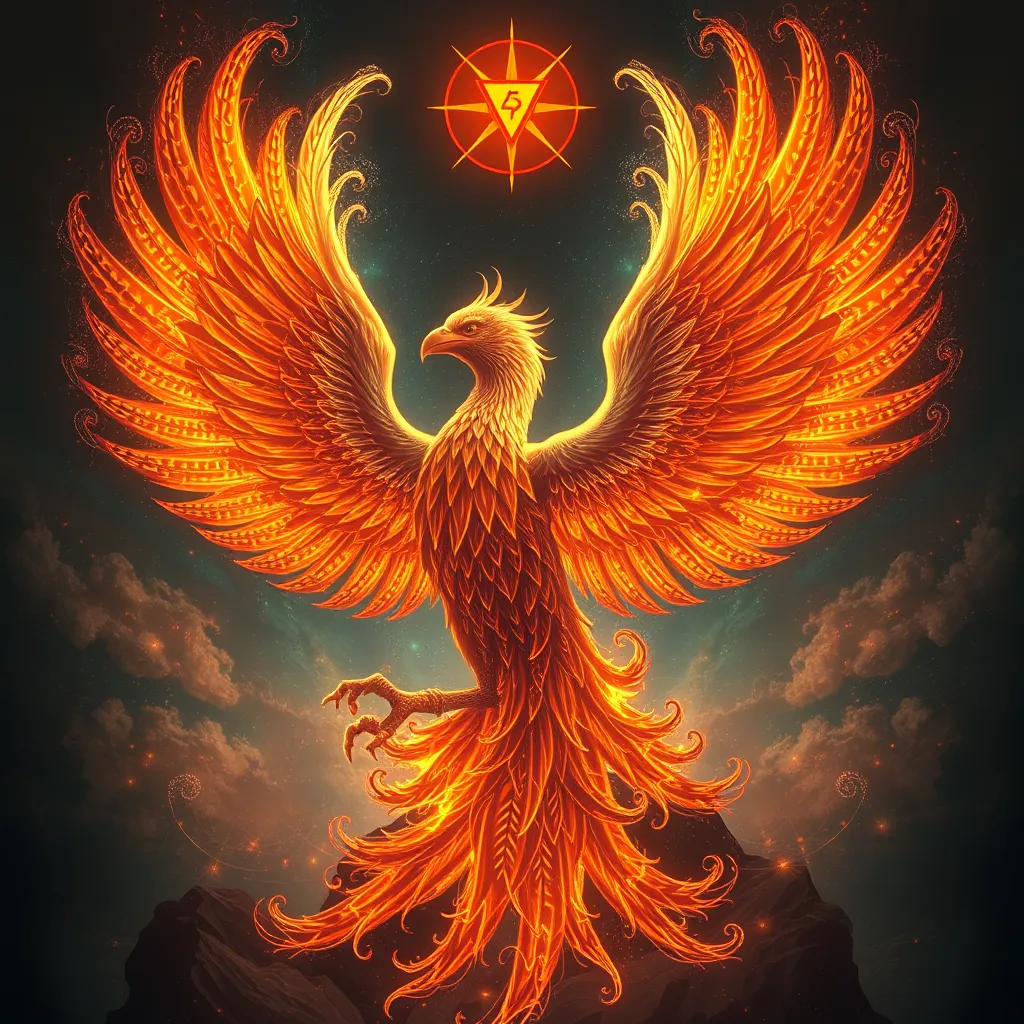The Phoenix in Hermeticism: The Kybalion and the Principles of Transformation
I. Introduction
Hermeticism is an ancient spiritual and philosophical tradition that encompasses a variety of teachings attributed to Hermes Trismegistus. It has significantly influenced Western esoteric thought, encompassing elements of alchemy, astrology, and theurgy. Central to Hermeticism is the exploration of the relationship between the divine and the material world, emphasizing the interconnectedness of all things.
Among the many symbols found within this tradition, the Phoenix stands out as a powerful emblem of transformation. This mythical bird, known for rising from its own ashes, represents the cyclical nature of life, death, and rebirth. It embodies the idea that from destruction comes renewal and that through hardship, one can achieve a higher state of being.
The purpose of this article is to delve into the relationship between the Phoenix, The Kybalion, and the Hermetic principles of transformation. By examining these connections, we aim to illuminate the profound insights they offer regarding personal and spiritual growth.
II. Understanding the Phoenix Symbol
A. Historical origins of the Phoenix in various cultures
The Phoenix is a symbol that traces its origins back to ancient civilizations, including Egyptian, Greek, and Roman cultures. In Egyptian mythology, the Phoenix, known as the Bennu, was associated with the sun and creation. The Greeks adopted this symbol, depicting the bird as a magnificent creature that would spontaneously combust upon death, only to rise anew from the ashes.
B. The symbolism of death and rebirth
Throughout history, the Phoenix has been synonymous with the themes of death and rebirth. This cycle reflects the natural order of the universe, where endings lead to new beginnings. The process of the Phoenix’s death and resurrection serves as a reminder that transformation often requires letting go and embracing change.
C. The Phoenix as a representation of spiritual transformation
In a spiritual context, the Phoenix symbolizes the inner journey of self-discovery and enlightenment. Just as the Phoenix must undergo a process of destruction to achieve renewal, individuals are often required to confront their own limitations and challenges to experience profound personal growth.
III. The Kybalion: An Overview
A. Introduction to The Kybalion and its authorship
The Kybalion, published in 1908 by three individuals known as “The Three Initiates,” distills the teachings of Hermetic philosophy into seven key principles. While the authorship remains somewhat mysterious, the text is regarded as a cornerstone of modern Hermeticism, providing a practical guide to understanding the nature of reality and the self.
B. The significance of The Kybalion in Hermetic philosophy
The Kybalion is significant because it presents Hermetic teachings in a concise and accessible manner. It emphasizes the importance of mental mastery and the understanding of universal laws, which are essential for anyone seeking to navigate the complexities of life and achieve spiritual enlightenment.
C. Key themes and concepts presented in the text
The main themes of The Kybalion revolve around the nature of reality, the power of the mind, and the interconnectedness of all things. The text introduces the concept of the All, which represents the infinite and unknowable source of all existence, and emphasizes the importance of alignment with universal principles for personal transformation.
IV. The Seven Hermetic Principles
A. Overview of the Seven Principles outlined in The Kybalion
The Kybalion outlines seven Hermetic principles that serve as foundational concepts for understanding the universe and our place within it. These principles are:
- The Principle of Mentalism
- The Principle of Correspondence
- The Principle of Vibration
- The Principle of Polarity
- The Principle of Rhythm
- The Principle of Cause and Effect
- The Principle of Gender
B. Detailed explanation of each principle
1. The Principle of Mentalism
This principle states that “The All is Mind.” It posits that everything in the universe is a mental creation of the All, emphasizing the power of thought and consciousness in shaping reality.
2. The Principle of Correspondence
Famous for the phrase “As above, so below; as below, so above,” this principle suggests that there is a correspondence between different planes of existence, allowing us to understand the greater whole through the study of its parts.
3. The Principle of Vibration
This principle asserts that everything in the universe is in constant motion and vibration. Nothing rests; everything is in a state of flux, and understanding this can help individuals align with the natural rhythms of life.
4. The Principle of Polarity
This principle states that everything has its pair of opposites, which are actually the same in nature but different in degree. Understanding this allows one to navigate the extremes of life and find balance.
5. The Principle of Rhythm
The Principle of Rhythm indicates that there is a flow to all things, much like the ebb and flow of tides. Recognizing this rhythm can help individuals ride the waves of life’s challenges and opportunities.
6. The Principle of Cause and Effect
This principle emphasizes that nothing happens by chance; every cause has its effect, and every effect has its cause. Understanding this helps individuals take responsibility for their actions and choices.
7. The Principle of Gender
The Principle of Gender states that gender exists in everything and manifests as the masculine and feminine principles. This balance is essential for creation and transformation.
V. The Phoenix and the Process of Transformation
A. Connection between the Phoenix and the Hermetic principles
The Phoenix embodies the essence of the Hermetic principles, particularly the ideas of transformation and rebirth. Each principle can be seen as a stage in the process of personal transformation, akin to the cycles of the Phoenix.
B. How each principle relates to personal transformation and spiritual growth
Understanding and applying the seven Hermetic principles can facilitate deep personal transformation:
- The Principle of Mentalism encourages individuals to harness their thoughts to create desired realities.
- The Principle of Correspondence helps individuals recognize patterns in their lives, leading to greater self-awareness.
- The Principle of Vibration teaches the importance of energy and emotional states in influencing outcomes.
- The Principle of Polarity assists in finding balance between extremes, fostering resilience.
- The Principle of Rhythm encourages acceptance of life’s cycles, promoting patience and understanding.
- The Principle of Cause and Effect empowers individuals to take control of their decisions and their lives.
- The Principle of Gender fosters the integration of both masculine and feminine energies, enhancing creativity.
C. The cyclical nature of transformation as represented by the Phoenix
The Phoenix’s cycle of death and rebirth mirrors the transformative journey of individuals. Just as the Phoenix must be willing to shed its old form to emerge renewed, individuals must also embrace change, releasing old patterns and beliefs to allow for new growth.
VI. Practical Applications of the Phoenix Symbol in Daily Life
A. Techniques for embodying the principles of transformation
To embody the principles of transformation associated with the Phoenix, individuals can practice the following techniques:
- Journaling to explore thoughts and emotions, fostering awareness and mental clarity.
- Meditation to connect with inner wisdom and enhance mental focus.
- Mindfulness practices to remain present and recognize the rhythms of life.
- Setting intentions based on the principles to guide actions and decisions.
B. Case studies or examples of individuals experiencing personal rebirth
Throughout history, many individuals have experienced profound transformations that echo the Phoenix’s journey. For instance, renowned figures such as Carl Jung and Joseph Campbell have discussed the hero’s journey, which often involves facing challenges, experiencing a metaphorical death, and emerging renewed. These narratives resonate deeply with the Phoenix archetype and serve as inspiration for those on their own paths of transformation.
C. The role of meditation and mindfulness in embracing the Phoenix archetype
Meditation and mindfulness are essential practices for embodying the Phoenix archetype. By cultivating a mindful awareness of thoughts and emotions, individuals can identify patterns in their lives that may need to be released or transformed. Regular meditation can also foster a deeper connection with the self, facilitating



